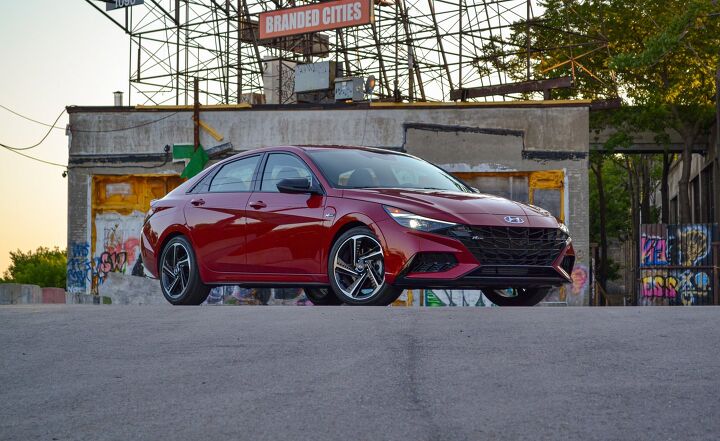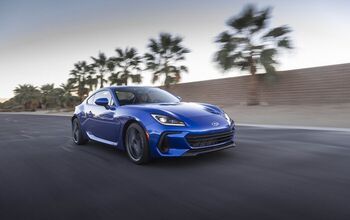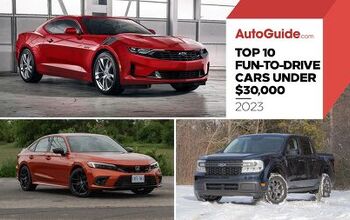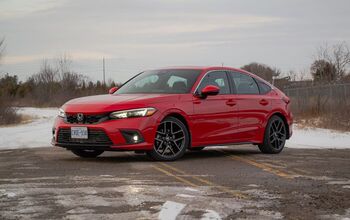2021 Hyundai Elantra N Line Review: Short N-Gagement

FAST FACTS
| Engine: | 1.6L I4 Turbo |
| Output: | 201 hp, 195 lb-ft |
| Transmission: | 7DCT, FWD |
| US fuel economy (MPG): | 28/36/31 |
| CAN fuel economy (L/100KM): | 8.4/6.6/7.6 |
| Starting Price (USD): | $25,105 (inc. dest.) |
| As-Tested Price (USD): | $26,205 (inc. dest.) |
| Starting Price (CAD): | $28,954 (inc. dest.) |
| As-Tested Price (CAD): | $28,954 (inc. dest.) |
It’s hard to pick faults with the regular models of the 2021 Hyundai Elantra lineup.
We said it “sets a new standard for the compact car class” when we crowned the Elantra our AutoGuide 2021 Car of the Year. If push came to shove, it’d be the Elantra’s lack of shove that would top my own list of demands. Hyundai’s engineers have done their level best to make 142 horsepower feel adequate, but that on-paper figure is still less than most of the competition’s base engine stats, nevermind the optional engines.
Get a Quote on a New Hyundai Elantra NThe Elantra N Line seeks to rectify this. A muscular turbocharged engine, a rejigged suspension setup to handle it, and a list price below that of a loaded Elantra 2.0? The ingredients are all here for a great budget sport sedan.
What’s new?
With the latest generation of Elantra sedan debuting at the tail end of last year, Hyundai has brought it in line with the brand’s traditional trim walk. The sporty model is no longer the Sport; it’s the N Line. A more extreme version will arrive later this year, simply called Elantra N. That one will share much with the Veloster N—naturally—including a 286-horsepower 2.0-liter turbocharged engine and either a six-speed manual or eight-speed dual-clutch auto transmission.
SEE ALSO: Hyundai Elantra N Line vs Volkswagen Jetta GLI Comparison: Healthy CompetitionWalking the ‘Line means a similar transmission choice, with the DCT down to seven gears here. Well, it’s a choice in America; Canadians can only have the two-pedal setup. The engine is the Hyundai family 1.6-liter turbo-four, the one you’ll find dang near everywhere in the brand’s lineup. It’s good for 201 horsepower and 195 lb-ft of torque here, all coursing through the 18-inch front wheels.
Gone is the torsion beam rear axle of the regular models, with a multi-link setup in its place. Hyundai has stiffened the springs as well, by 26 percent up front and a whopping 71 percent out back. The front brakes are larger, too.
The seventh-generation Elantra is already a pretty dramatic shape, so the N Line treatment is comparatively tame. The afore-mentioned 18-inch wheels are one obvious change; the unique front bumper is a little harder to catch. Out back, a black lip spoiler and a modest dual-tip exhaust are the only tells. Now the Elantra has the firepower to back up those fast looks.
Driving experience
The 1.6-liter provides a welcome blast of torque from barely off idle. At low speeds it’s enough to overwhelm the front tires, a careful right foot never being a replacement for the absent limited-slip differential. The turbo-four even sounds pretty good too, a bassy parp-parp emanating from the dual-tip exhaust.
The torque steer gives the N Line a scrappy nature on first blush, but put some speed under those wheels and the package gels. The stiffened suspension is clear from the off, the Elantra showcasing great composure, yet never feeling brittle when restrained to rough city streets. Fling the car into a corner and the body will still lean, but that’s the Elantra telegraphing its limits early and clearly.
There’s good grip from those 18-inch all-season tires; going with the manual transmission nets even grippier summer performance rubber. The brakes are strong as well, standing up to repeated stops without the pedal going spongey. Working in the Elantra N Line’s favor is its weight, or lack of it: the dual-clutch model is just 3,020 pounds (1,370 kilograms), less than the car it replaces. That lightness translates to the steering, as well. It’s short on resistance and feedback; easy for around-town maneuvering, but a barrier to driver confidence on flowing back roads. There’s a hint of initial turn-in vagueness that never completely goes away, regardless of drive mode.
SEE ALSO: 2022 Honda Civic Review: First DriveQuick shifts from the dual-clutch transmission are most welcome, with only the occasional bout of low-speed hesitation the breed is known for. Flip over to Sport Mode and the Elantra will hold onto gears longer, and spend less time between them. The N Line responds quickly to pulls of its wheel-mounted paddle shifters for single changes, but can get held up when more are needed. For the added level of control it would provide, the manual would be better, not to mention even more affordable. Sadly, it’s not an option in Canada.
The rest of the package
I’m a big fan of the Elantra’s interior in its top-shelf spec, and the N Line carries over most of that goodness. The driving position is excellent, a low seat offering a welcome riposte to the rolling stilts factories that are modern crossovers. The seats themselves are ever so slightly more bolstered, maintaining excellent comfort with a dash of added support mixed in. The combination of leather and cloth is most welcome; the fully manual seat adjustment less so. It’s a small concession to make for such an affordable package, though.
There are other apparent de-contenting moves to hit that list price. Some aren’t even that bad, though. The central touchscreen is now 8.0 inches instead of the 10.25-inch unit in the Limited (Ultimate in Canada), but it gains wireless Apple CarPlay and Android Auto, so I’d even call that a net positive. There’s still wireless charging too, so consider this an off-leash area for your phone. The native infotainment system is fine, with highly legible menus and quick responses.
The fully digital instrument panel is gone too, but the N Line uses seriously cool white-on-black gauges with a deep cowl overtop. Red highlights abound, including the checkered-flag redline on the tachometer. To the left of the cluster, Hyundai has dropped the drive mode selector. Is this an admission that the noteboard feature was kind of silly? I’m taking it that way.
Cabin material quality is generally good. The exception is again with the crossbar to the right of the shifter. Reaching over, the driver’s hand will run right across the far-side seam of the plastic. It’s something I noticed on the Elantra Hybrid—though not on the two-tone interior of the top Limited/Ultimate. Space is adult friendly in both rows, with lots of rear-seat legroom for the taller folks.
SEE ALSO: 2021 Hyundai Elantra Hybrid Review: Sneak AttackOn the driver assist side, the Elantra N Line comes well-stocked. Standard features include forward collision-avoidance with pedestrian detection, lane departure warning, lane keep and follow assists, auto high-beams, blind-spot collision avoidance, and rear cross-traffic alert. Hyundai also includes its Driver Attention Warning and Safe Exit Warning.
Who’s the competition?
Hot-ish compact four-doors are thin on the ground these days. The Honda Civic Si is having a year off, though expect it to return next year using the bones of the excellent 2022 sedan. Honda has confirmed it will continue to feature a genuine row-your-own manual, too.
Nissan? Nope, even if the current Sentra is better than it’s been in decades, and would make a good base. Toyota? There’s the limited-edition Corolla Apex, a bone-achingly stiff car seemingly made exclusively for chiropractors to extract more money from their clients. Mazda has the 3 Turbo, which is pretty, powerful, and pricey, not to mention all-wheel drive.
There’s the small matter of the Volkswagen Jetta GLI, too. When we pitched the Elantra against the Peoples’ hot four-door it couldn’t topple the VW. More accessible power and an excellent manual transmission are the Jetta’s strong points; its higher price tag isn’t.
SEE ALSO: Toyota Corolla vs Hyundai Elantra ComparisonThe Elantra N Line maintains Hyundai’s long-standing reputation for value. Priced from just $25,105 including destination ($28,954 CAD), it undercuts the VW by a few grand, and should do the same with the upcoming Civic Si.
Verdict: 2021 Hyundai Elantra N Line Review
The 2021 Elantra N Line addresses one of the few perceived weak points of the regular Elantra: a lack of kick. The turbo engine imbues the compact sedan with some serious get-up-and-go, enough to highlight the competent chassis underneath.
You can’t shake the feeling that the N Line is pulling its punches, though. Maybe it’s because, unlike the Civic Si and Jetta GLI, both of which have higher-performing siblings in different form factors, the Elantra is a half-way house between cooking models and the full-power Elantra N. The lack of a manual transmission option in Canada is an unfortunate move, too. Compact sport sedans are all about fun, and while the DCT is a solid example of the breed, a three-pedal setup would increase the engagement. It’s especially strange as Hyundai Canada made the effort to include a base model manual Elantra, something the US does without.
It’s true, there are more well-rounded sport sedans out there in this part of the market. But if you’re on a strict budget, the Elantra N Line still offers an outsized amount of fun for its meager price tag.
Become an AutoGuide insider. Get the latest from the automotive world first by subscribing to our newsletter here.
LOVE IT
- An engine to match the chassis
- ... and the looks, too
- Wireless Apple CarPlay/Android Auto
LEAVE IT
- DCT only in Canada
- Torque steer in low-speed corners
- We miss the hatchback, Hyundai

Kyle began his automotive obsession before he even started school, courtesy of a remote control Porsche and various LEGO sets. He later studied advertising and graphic design at Humber College, which led him to writing about cars (both real and digital). He is now a proud member of the Automobile Journalists Association of Canada (AJAC), where he was the Journalist of the Year runner-up for 2021.
More by Kyle Patrick








































Comments
Join the conversation